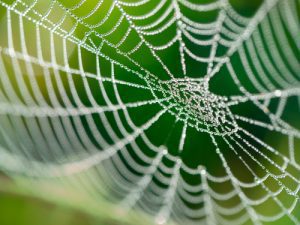In the News – Spider Silk From Silkworms
By Chris Williams on January 17, 2012.
Hard-working silkworm larvae have been used for centuries to spin silk strands into cocoons that are then painstakingly unwound, braided into silk threads, and processed to produce silk fabric. Poor silkworms, scientists have decided that their silk is just not good enough. They’ve genetically engineered the silkworms to produce spider silk instead by inserting DNA with spider silk code into the larvae.
There’s a reason scientists want spider silk—and lots of it. Spider silk is incredibly tough stuff. Weight for weight, it is stronger than steel and just as indestructible as Kevlar. It can stretch up to 1.4 times its relaxed length and can maintain these properties to a temperature of –40 degrees F. For 25 years, researchers have been trying to mass-produce spider silk for industrial uses. Scientists have planted synthetic spider silk genes in a number of different hosts, including bacteria, yeast, plants, and even goats. The enhanced goats were able to produce limited quantities of silk proteins in their milk, but not enough for mass production.
 Previous attempts to incorporate spider silk proteins into fibers spun by silkworms resulted in low yields. But the recent technique from Dr. Donald Jarvis of the University of Wyoming, and colleagues, led to fibers at least as tough as spider silk and stronger than those normally spun by silkworms. The researchers say there’s no reason why silkworms could not be used as factories for manufacturing tough silk fibers containing spider silk proteins. This is nothing new for the silkworms. The placid larvae of the silkworm moth, Bombyx mori, have already been successfully farmed for centuries.
Previous attempts to incorporate spider silk proteins into fibers spun by silkworms resulted in low yields. But the recent technique from Dr. Donald Jarvis of the University of Wyoming, and colleagues, led to fibers at least as tough as spider silk and stronger than those normally spun by silkworms. The researchers say there’s no reason why silkworms could not be used as factories for manufacturing tough silk fibers containing spider silk proteins. This is nothing new for the silkworms. The placid larvae of the silkworm moth, Bombyx mori, have already been successfully farmed for centuries.
Why, you ask, don’t scientists just farm spider silk directly from spiders instead of using silkworms? Well, spiders are just a lot harder to “farm.” They are territorial and they tend to eat each other, cutting down on production. It’s tough to keep a herd of working spiders together. Silkworms are much more docile and even-tempered; they have that herd instinct.
What will the world do with this silkworm-produced spider silk? A number of uses have already been identified in the medical field where it could be used for procedures requiring finer sutures, and as bio-materials for wound dressings, artificial ligaments, and tissue scaffolds. Other planned uses are in bulletproof vests, automobile airbags, and parachutes. (Source: Care2.com, Jan. 3, 2012)